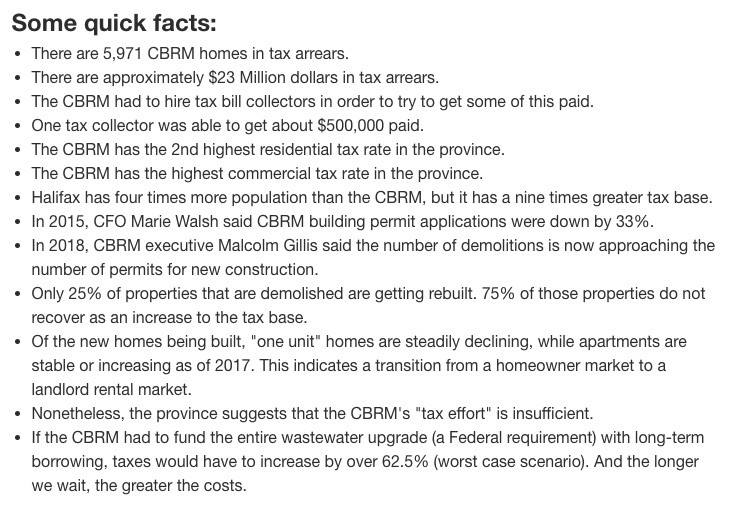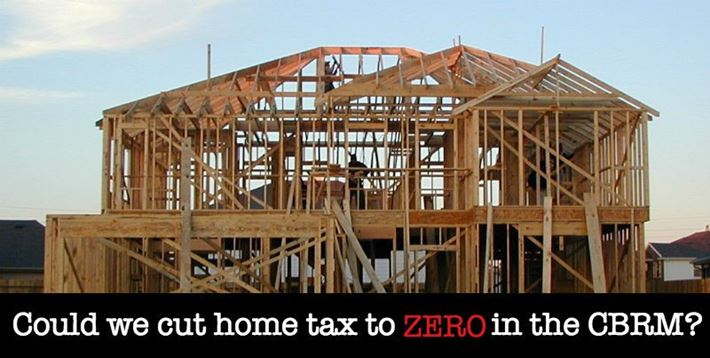Don't worry, this isn't a full bait and switch from the title. But... fixing the tax cap is the right idea, in general principle. Take note that I didn’t say “how” to fix it. Before I get into the zero tax idea, first just a bit of info on why thinking about solutions beyond removing the tax cap is important.
There are two main issues with removing the tax cap for our current political leadership:
- For one, are we really trusting the same type of people who created this mess to figure out how fix it?
- And secondly, actually removing the cap is so politically volatile, will provincial leaders really have the courage to actually do it?
The CBRM Chief Administrative Officer, Marie Walsh, recently proposed three options to Council.
Options 1 and 2 were essentially the same. They both boiled down to phasing out the tax cap with increases in assessment each year from 10 to 15%, over 7 to 10 years.
Option 3, mostly just there to steer everyone back towards Option 1, was to rip the band-aid off in one shot. That is, eliminate the tax cap completely in one year, but reduce tax rates. Hint: It wasn't really intended as a serious option.
While a phase-out approach seems to fit with the general consensus and would help to avoid big financial “whiplash” effects on taxpayers, these solutions really don’t show much ingenuity. They also offer no modelling as to the market effects to be expected year after year.
I'm certainly not opposed to practical solutions. But I do caution that when the tax cap was introduced, I bet everyone advocating for it would have told you that it was a... practical solution.
The reason they missed the obvious was because they apparently did not do any modelling as to the long-term effects of the policy. If they had, it wouldn’t have been put in place, because the adverse effects could have been foreseen.
Here’s the self-reinforcing set of problems in the CBRM:
Our tax rates are too high. They’re unfair because people with the same home values are paying different amounts of tax. And this is distorting the market, and working against any potential it may have for growth.
You could fill a Ph.D. thesis in Economics with the adverse side effects that these basic conditions create.
If our tax base was actually growing, it would be easier to resolve the broken tax cap system.
The reason it would be easier is that new homeowners would be joining the tax base, and easing the burden on all others.
If tax rates can be lowered, when the tax cap starts coming off, the financial effects wouldn't be as negatively impactful on homeowners.
But the scale of this problem is immense:
We can’t grow our tax base right now because we have high unemployment (> 15%), lower median household incomes, and tax disincentives to building new homes or business properties here.
While we’re currently stuck within an economic downward spiral that reinforces the adverse effects on all areas, what if we jumped to a system that went entirely in another direction?
If taxes are a problem, and new homes aren’t being built, let’s drop the tax on them to 0%.
If unemployment is a problem, and new jobs aren't being created fast enough, won’t a boom in new home construction help employ those in the trades, plus spin-off?
If people are having a hard time qualifying to buy/build a home, won’t new employment and growth in the local economy help that?
Note: There are all kinds of potential solutions. Each solution brings with it a potential for side-effects that could be adverse. Can you spot them?
Here's the proposal:
- All new homes constructed are capped at 0% assessment in their first year.
- For years 2 through 8, new homes increase in capped assessed value (which starts at 0%) by 15% until they reach their actual market value.
- By the time they are paying taxes on their full assessment, the tax base will have had time to grow and will have enabled us to lower tax rates for everyone.
That’s it.
Then we've instantly created an environment for the tax base to start growing and for the trades to support new jobs.
Zero tax on new home construction sends a compelling message:
- People who are thinking of building out West, start thinking of building at home in Cape Breton again.
- People who have already moved, now reconsider building their retirement or vacation home in Cape Breton again.
- New homeowners can start qualifying to build new homes instead of having to buy lessor homes than they desire from our old and ageing home inventory.
- Seniors who couldn’t downsize due to taxes can now afford to do so again. The tax cap no longer locks them in their older, less energy efficient homes.
- People whose income level would lead to them having difficulty building homes with our high tax rates would then have a greater shot at having their monthly income support new homeownership.
As the new housing growth increases the tax base, and the economic activity in the trades stimulates growth, we can start to look at lowering tax rates across the board.
But there’s some math we need to be aware of.
Our tax base isn’t going to fix itself without intervention.
Here’s something that can help hammer this point home by the numbers.
Tim Houston recently became the leader of the PC Party of Nova Scotia. Part of his campaign included a pledge that he would double provincial Equalization transfers resulting in an additional $15 Million more per year coming into the CBRM.
That $15 Million would allow us to drop our tax rates by 21%.
If that happened, without any changes to the tax cap, you’d only be paying 80% of what you’re paying now. Granted, that’s only if we reinvested the new $15 Million directly into offsetting the tax burden on CBRM homeowners. P.S. That's ultimately what the intent of Federal Equalization is in the first place.
But here’s the opportunity for awakening. I’ll use some rough numbers.
For simplicity, let’s go with 2% being the home tax rate, and let’s go with the value of a new 2-3 bedroom bungalow style home of $250,000.
The question is:
How many of these new homes (i.e. new homeowners) would we need to have in order to raise an additional $15 Million in taxes for the CBRM?
Well, the answer is about 3,000 new homes...
- What if we needed to reduce our tax rate by only about 10%? Well, we’d need roughly 1,500 new homes built.
- What if we needed to reduce our tax rate by only about 5%? Well, we’d need roughly 750 new homes built.
It should be fairly clear now.
Our economy doesn’t support the growth in tax base necessary in order to make changes in our tax structure.
And as long as an adverse tax structure is in place, we’re working against ourselves.
We can’t recover based on a slow process, especially when that slow process could be harmful to some CBRM taxpayers.
By reducing new home tax to 0%, we’ll have made a bold offer, and one that would be difficult for people to pass up if they are even close to a home-building decision.
With such a policy, we can keep people here, we can bring people here, we can start growing our tax base, we can prepare to lower our taxes, and we can create jobs and boost the local economy.
Ideally, I’d drop taxes to zero on new construction while immediately lowering our taxes by 21%. That would be possible by either securing the $15 Million pledged by Tim Houston or convincing the current Liberal government to match his offer right now.
That way, we’d celebrate a significant tax break, while at the same time sparking new housing development.
Taking the cap off with a slow phase out, in the absence of any other economic policy, isn’t going to rescue us from anything.
Meanwhile, given that it’s so politically hot, the chances of getting provincial approval to do so from any government is probably a long shot. Reducing taxes to zero, however, will have less political opposition. While it's seemingly a bolder strategy, it may actually come with less political risk.
Would zero tax on new home construction motivate you or someone you know to build here in the CBRM?
NOTE: The views expressed above are my own and do not represent lokol (goCapeBreton.com). Read more







19
Log In or Sign Up to add a comment.- 1
arrow-eseek-e1 - 8 of 8 itemsFacebook Comments